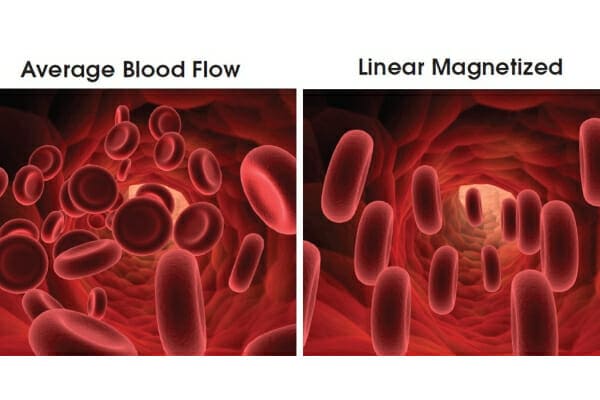PEMF therapy for dogs (i.e. pulsed electromagnetic field therapy) is quite beneficial for dogs who have chronic orthopedic problems, acute wounds or injuries, or other painful conditions. Integrative veterinarian Dr. Julie Buzby invites PEMF expert Lisa Miksis to the blog to explain what PEMF therapy involves and how it could help your dog have more good days.

The vast majority of us do not give a second thought to the role of magnetic and electrical fields in our daily lives. Well, let’s be honest, most of us do not even give it a first thought! But you may want to if you are currently caring for a dog with osteoarthritis, disc related conditions, an acute injury, a bone fracture, or any other soft tissue condition that results in inflammation, pain, and reduced mobility.
What is PEMF therapy for dogs?
But let’s back up a moment and quickly familiarize ourselves with the basics of both magnetic and electrical fields. This information can help you understand how pulsed electromagnetic fields (PEMF) can help your dog enjoy a more vibrant quality of life!
Electric fields
Let’s say you are experiencing a rapid heartbeat or an anomaly in the rhythm of your heart. Your physician will probably order an electrocardiogram (EKG). This test measures the strength and timing of electrical impulses passing through each part of your heart. The impulses are what dictate your heart rate and rhythm.
And that’s not all these currents do. As it turns out, your body is full of electrical charges that control everything from nerve communication to muscle contraction and organ function. These electrical charges result from positive and negative ions that exist in the body. Keeping them in balance is crucial for the cells to operate efficiently.
Magnetic fields
When you step outside and feel the warmth of the sun on your face, it brightens your day. But you probably don’t stop to express a moment of gratitude that you are not being bombarded by charged particles from the solar wind. These particles could strip away the earth’s atmosphere and destroy all life as we know it! Thankfully, the earth’s magnetic field protects us from this fate. No magnetic field would mean no atmosphere that is fit for life on earth.

Additionally, migratory animals such a birds, butterflies, and whales rely on the earth’s magnetic field. It provides the information they need for navigation during migration.
These amazing magnetic fields are created by putting electrically charged particles in motion. That is exactly what is happening inside the core of the earth when the molten rock moves as the earth spins on its axis.
Electromagnetic fields
Now, it is time to put those two concepts together. If we take the electric particles and really accelerate them (think of it like a river flowing rapidly) we can create a magnetic field perpendicular to the flow of the electric particle river. This creates an electromagnetic force or field. Electromagnetic force is one of the four fundamental forces that govern all interactions in nature. Gravity is another of these forces.
Even though we cannot see or feel these electromagnetic fields, they surround us and are a vital player in all life processes. On a huge scale, light is an electromagnetic force. And on a microscopic scale, all cellular activity is controlled by cells signaling each other. Those messages are carried by positive and negative ions.
What does PEMF therapy do?
Magnetic fields, specifically pulsed electromagnetic fields (PEMFs), at the right intensity, frequency, and application duration can positively influence these cell signaling processes. This can have incredible benefits on the body, especially when the cells are not communicating effectively due to injury, age, illness, and stress.
Research and clinical trials looking at the effects of magnets, electromagnetic fields, and PEMF on the body and cells have been ongoing since the early 20th century. The following are some landmark Food and Drug Administration (FDA) clearances for PEMF:
- 1979—Approved for treating non-union bone fractures and stimulating bone growth
- 1998—Approved for urinary incontinence and muscle stimulation
- 2004—Cleared as adjunct to cervical fusion surgery
- 2006—Approved for treatment in depression and anxiety
- 2019—Cleared as adjunctive treatment of postoperative pain
What are the benefits of PEMF therapy for dogs?
Researchers have identified many of the cellular processes PEMFs influence1. The core mechanisms of action lead to:
- Cell proliferation (i.e. multiplication) and collagen formation
- Reduction of inflammation
- Increase in circulation
- Increase oxygenation of tissue
- Pain reduction2

As it relates to veterinary medicine and animal health, these effects can have an incredible benefit in managing conditions in dogs such as:
- Osteoarthritis in dogs3
- Intervertebral disc disease (IVDD) in dogs
- Wound healing
- Bone fractures4
- Acute and chronic ligament, tendon and muscle conditions such as torn ACL in dogs
- Signs a dog is pain
- Spinal cord injury (as discussed in an article from NC State University College of Veterinary Medicine on electromagnetic field therapy for dogs with spinal injuries.)
7 FAQs about PEMF therapy for dogs
Now that you understand a bit of the theory behind electromagnetic fields and the potential benefits, let’s explore some practical aspects of PEMF treatment. Over the years, I have answered many great questions about PEMF therapy from dog parents. Some of the most common are compiled here.
FAQ #1: How do I know if PEMF is the right choice for my dog?
A consultation and close communication with your veterinarian is a must when considering any new therapy for your dog. He or she can help determine if PEMF treatment could be a good option.
FAQ #2: Does my dog need to get PEMF therapy at a veterinary clinic or rehab center or can I do it at home?
Clinics often offer PEMF therapy as part of a routine therapy treatment. However, many dogs can benefit from using PEMF more frequently than you can practically go to the clinic. Luckily, there are many options for use at home—PEMF loops, PEMF beds or mats, PEMF dog jackets, and more . You can either purchase a PEMF machine directly from your veterinarian or purchase or rent one from a PEMF company.

FAQ #3: What technical specifications should I be looking for in a PEMF device?
PEMF companies use a wide range of PEMF intensities, waveforms, frequencies, and delivery methods. Understandably, this can sometimes make the choices feel overwhelming. Two important considerations are the intensity and pulse frequency.
Intensity
Keep these factors in mind when looking at the intensity of a PEMF device:
- PEMF intensity or strength is commonly measured in tesla (T) or gauss (G). The stronger the intensity, the deeper the therapeutic field will get. (For comparison, the strength of the field emitted by the Earth is 25-65uT (microtesla) or 0.25-0.65G.)
- For a wound, surface condition, or for a calming effect on the central nervous system, a low intensity system below 1G in peak intensity can be effective.
- On the other hand, a device in the 2-30G range for peak intensity is going to be the most effective for triggering mechanisms to positively influence tissue regeneration and repair, manage inflammation in larger joints or deep tissue, or promote bone healing.
Pulse frequency
When evaluating pulse frequency, you should know:
- Most of the devices on the market today fall into the pulse frequency range of 5-60Hz. That is because this is the closest range to the frequency emitted by the Earth, which is approximately 7.83Hz. Look for a device for your dog that falls into this category.
- Ideally, you want a device that offers you the capability to select from a few different frequencies in one device. Some conditions are found to respond better to one frequency versus another. Having a device that allows you to select from at least three frequencies will expand the use of your PEMF device.

FAQ #4: How do I pick the best PEMF machine for my dog?
It is best to do your homework before settling on the PEMF device that will be ideal for your dog. Factors to consider are:
- How long has the company been using their technology, frequency, and intensity for dogs? And what results do they have?
- Are you looking simply to relax your dog or to treat a specific condition?
- Do you need a PEMF bed to treat many tissue areas at once or a smaller PEMF loop to address smaller, target areas?
- What are the customer support options for both treatment questions and device issues?
- What is the longevity of the device?
- Is it rechargeable or disposable?
- What is the price?
FAQ #5: What should I expect when I use PEMF on my dog and when should I see results?
The main results that you should see are:
- Reduced pain and inflammation
- Increased mobility
- Healing of acute soft tissues injuries
- Overall positive impact on quality of life
However, how these results manifest and when they occur will vary widely from dog to dog. Factors that may influence when results become evident include:
- The dog’s age
- Overall health of your dog
- The condition you are treating (acute or chronic)
- The dog’s activity level
- Other therapies or pharmaceuticals you are using
A dog can get immediate pain relief from just one treatment! But the ultimate effect of PEMF therapy is cumulative. It could take a week to a month for the mechanisms triggered by the therapy to manifest in noticeable, lasting results. So be patient.
FAQ #6: What treatment protocol should I follow?
This will be device specific. In general, treatments usually vary from one 30 to 60 minute treatment a day to multiple 10 to 15 minute treatments in one day.

FAQ #7: Are there any negative side effects or contraindications to PEMF therapy?
Using a PEMF device in the intensity and frequency range noted above should have no negative effects on your dog. This is because it is a non-invasive therapy that will pass through a healthy cell with no impact.
However, there are a few contraindications with PEMF, as with any therapy, that you should be aware of. Do not use PEMF therapy on:
- Pregnant dogs—it could interfere with the natural growth process
- Areas that are actively bleeding or hemorrhaging
- Dogs undergoing cancer treatment prior to consulting with your veterinarian
- Dogs under the age of one year
Talk to your veterinarian about PEMF therapy
As you have discovered, PEMF therapy can be a great way to improve your dog’s quality of life. It is non-invasive, easy to perform in the comfort of your home, and virtually risk free. If you think that PEMF therapy might be a good choice for your dog, please consult with your veterinarian or veterinary rehabilitation professional. Then, if they give you a green light and you decide to purchase or rent a device, keep in mind the answers to the FAQs above.
From Dr. Buzby: My goal as a veterinarian and the founder of Dr. Buzby’s—The Senior Dog Company is to help improve the lives of senior dogs and give them more good days. I firmly believe that PEMF therapy can do that for some dogs who are struggling with pain and inflammation.
About the author
Lisa Miksis is President at Respond Systems Inc. in Branford, CT, a company that manufactures and sells veterinary therapy devices, including PEMF therapy systems, worldwide. She has BS from Boston College in Biology and leads Respond Systems’ R&D efforts related to PEMF technology and its effect on cellular processes that contribute to delivering pain management, healing, and disease and injury prevention.
References:
1. Cristiano Luigi, Pratellesi Tiziano. Mechanisms of Action And Effects of Pulsed Electromagnetic Fields (PEMF) in Medicine. Jrl of Medical Research and Surgery (2020) 1:6.
2. Anthony J. Lisi , Mickey Scheinowitz, Richard Saporito, Anthony Onorato (2019). A Pulsed Electromagnetic Field Therapy Device for Non-Specific Low Back Pain: A Pilot Randomized Controlled Trial. Pain Ther (2019) 8:133-140.
3. Pinna S, Francesca Landucci, Anna Maria Tribuiani, Fabio Carli and Antonio Venturini . The Effects of Pulsed Electromagnetic Field in the Treatment of Osteoarthritis in Dogs: Clinical Study. Pak Vet J, 2013, 33(1): 96-100.
4. Hallie B Murray, Brian A Pethica. A follow-up study of the in-practice results of pulsed electromagnetic field therapy in the management of nonunion fractures. Orthopedic Research and Reviews 2016:8 67-72.
Have you tried PEMF therapy for your dog?
Please share your experiences below.


can you use pemf therapy on a large dog that has screws and plate in his leg for bone recovery?
Hi Sylvana,
Yes! From all my research, it seems as though PEMF should help reduce inflammation, reduce pain, and encourage new bone growth. Of course, if you have any concerns, don’t hesitate to discuss them with your vet. Wishing you and yours all the best!
Hi Dr Buzby,
If my dog has been down flat on one side for a two and a half weeks from either a spinal tumor or IVDD (no firm diagnosis) and is exhibiting a fever of 103.5, and is crying frequently, is this treatment appropriate?
And should he be laying on the mat or under it? Should he be sedated? What are the risks associated with the Bemer machine and therapy?
Dear Angi,
I am so sorry your pup is in this terrible situation. To be honest, what you describe has me VERY concerned. A spinal tumor or IVDD should not cause a fever. If your dog has been lying flat on one side, crying out in distress, and feverish for over 2 weeks they need to be taken to an emergency clinic right away. Your boy is suffering and needs urgent medical care that a PEMF mat cannot offer. Hoping you can advocate for his well-being and get him the relief he needs. Praying for healing and peace.
Hi can pemf help with collapse trachea.
Hi Susan,
I am not sure if PEMF has been studied as a therapy for this particular condition. With that being said, we do know that PEMF helps reduce inflammation. Since inflammation can play a role in increasing the severity of collapsing trachea, it makes sense that if you can reduce inflammation, you may be able to reduce the symptoms of this condition. Ultimately, I can’t say for sure that it would help, but I don’t think it would hurt either. Thanks for asking this great question!
Hi , How many HZ do you recommend I set my device to for my 7lb dog? Thanks
Hi Rita,
I am glad you are going to give PEMF a try with your pup. Unfortunately, I am not able to give you a specific number as an answer. The recommended frequency can vairy depending on what condition you are trying to treat and the type of PEMF unit you are using. The manual that comes with the device should offer some guidance. If you still need help, I encourage you to reach out to your vet since they are more familiar with your dog’s medical details. Hoping for positive results and wishing you all the best!
Can I know why it can’t be used on a dog under the age of one?
Hi Susan,
This is a great question! PEMF increases the growth rate of bone cells and is thought to be able to have an effect on growth plates in young dogs. If a growth plate in a bone closes prematurely, it can deform the bones and alter joint angles leading to problematic health issues. I am not sure if there is definitive research to prove this as it is not common practice to test new therapies on puppies. Thank you for bringing up this important topic!
We are in the UK and have a 13yo Labradoodle with Arthritis. We give him Riaflex supplements and he has Rheumocam from the vets. After having physio at home where they used a PEMF loop machine we looked into and purchased our own bed from Respond Systems – it’s only been 4 days of 30 min treatments on the lowest frequency but he does seem less stiff when sitting and getting up and the last 2 nights he has come upstairs to bed which he had recently stopped doing.
We keep him active with just 20 minute walks most days and although he is hesitant to get on the bed if you sit and fuss him the whole time he relaxes and lies for the full treatment time.
As they recommend 7 days at 5 frequency we are doing that and may up to 10 after that to see if better for him. We will just monitor and see how he does. We may stick with 5 and do 2 treatments of 30 but early stages yet but encouraging.
Hate to think of him being sore or uncomfortable so although expensive really happy with our purchase
Hi Rachel,
I am glad you are starting to see subtle signs of improvement in your pup after using PEMF therapy at home. I appreciate you taking the time to share your experience with us. Hoping for continued success and relief for your sweet boy. Take care and keep up the good work!
our 8 yr old schipperke is slated to be neutered in 3 weeks and I read this is not always the best with an enlarged prostrate. we notice his fur is very dry. discolred. His blood work is good. He still active and he eats well. his prostrate is markedly enlarged though since last year. Ribbon feces. He must be neutered according to our rural vet. I live in a small area of iowa,. the closest veterinarian to using perfect is 3 hours away in
Des Moines. I read that if we are able to get this therapy for our dog we would have to make a few trips back and forth there, which is difficult especially for me as a senior with a back condition. Would I be able to administer this treatment myself at home? (I also have a spinal cord stimulator) iWhat particular model should I look for? He is on a very good diet and he eats the vet rx gastrointestinal food from science diet. he is on Royal Canin sensitive dry food.. He is through a very responsible breeder. If there’s a chance that neutering could actually bring on some type of a prostate cancer that he didn’t have to begin with I would be very concerned about it. I love him. (Coconut) I just read that.
Thank you for taking the time to look at this. I really appreciate it.
Hi Elizabeth,
I understand your concern for your senior guy as he lives with this prostate issue. I was not aware that any veterinary clinics were offering PEMF therapy as this is usually something that is done at home. There are many companies that sell PEMF mats and beds that you can purchase and use daily at home for your pup. I don’t have a specific brand to recommend as there are just too many different options to be familiar with them all. I have not seen any data about using PEMF to treat prostate enlargement, but that doesn’t mean it won’t have beneficial effects. The gold standard of treatment is to neuter the affected dog as the prostate issue is hormone responsive. Once the body is no longer making testosterone, the prostate should shrink back down to a normal size. It is true that neutered dogs have a higher risk of prostate cancer, but this is usually seen in dogs neutered earlier in life. I would not be overly concerned about this developing in your senior boy. Here is a link to another article with more information: Enlarged Prostate in Dogs: Know the Symptoms & Causes
Hoping you can find the answers you need to make the best choice for your sweet boy. Best wishes and take care!
Great article. Do you have any recommendations for a high intensity PEMF dog bed? I have an 8 yo 100lb Akita that had CCL surgery on his left leg in 2020.
We just found out 3 days ago he has torn his CCL on his right leg. We have opted to not do the TPLO surgery again, he leans against everything to keep his weight off his left leg, we don’t feel it would be able to support all his weight during recovery.
We have opted for pain management and it sounds like PEMF might be helpful. I am, however, having a difficult time finding any dog mats that list the Gauss ratings. He is a large dog, and I would like to find the highest Gauss mat we can find.
Thank you,
Danielle
Hi Danielle,
I am glad you are searching for ways to help your Akita with pain relief and healing. Unfortunately, I am not familiar with what intensity levels are recommended for different conditions. It may not be beneficial to use a high intensity PEMF mat for a CCL tear. This would be something that I would ask the specialists when trying to get a recommendation. I too have not seen dog products with a Gauss rating but have seen them commonly listed for human products. Hoping you can find the answers you need and help your boy return to better function. Take care and keep up the good work!
I would call Centurion. I have the Pemf ring and blanket. They will help you. They usually deal with horses and people, but I’m sure they can guide you. They are a Canadian Company and been selling since the 1980’s.
Are PEMF devices harmful to the brain of small dogs (17 pounds)? I am considering buying a PEMF bed device, but am concerned about its affect on my little Italian Greyhound’s brain..
The Assisi loop has helped him with his back and neck disc problem,.
Thank you.
Hi Glor,
I am glad you have had good success using the Assisi loop with your little pup. I am not aware of any issues that PEMF would cause to your dog’s brain. As always, I would follow the manufacturer’s instructions on how to operate the device and take note of any cautions based on size or breed. I hope you will see the results you are looking for. Feel free to leave an update and let us know what you think!
This blog provides a comprehensive and insightful overview of PEMF therapy for dogs, highlighting its potential benefits for various conditions like osteoarthritis, injuries, and inflammation. The detailed explanations of electric and magnetic fields, combined with practical FAQs, make the information accessible and valuable for dog owners considering this therapy. It’s encouraging to see how PEMF can improve a dog’s quality of life, and the emphasis on consulting with a veterinarian ensures a safe and tailored approach. Thank you for such a well-rounded and informative post! Has anyone here tried PEMF therapy for their dog? I’d love to hear about your experiences and results!
Hi Almagia,
Thank you for the great feedback! Best wishes to you and yours. ♥
We have been using PEMF therapy for our dog for the past five to six weeks and have noticed significant improvements. He was diagnosed with severe arthritis in his back and neck. He has also been on prednisone and muscle relaxers and we also used acupuncture. Therefore, It’s difficult to isolate if it was due to the PEMF therapy alone. Having said that, I do believe it has been very helpful in his overall improvement. It’s expensive, but I think it’s worth it!
Hi Wendy,
I am so glad to hear your boy is feeling better and able to find some relief from his pain. Thank you for sharing your experience with us. Wishing you both nothing but the best. Keep up the great work!
may i ask ehich machine are you using?
Hello! In November of 2022 my dog was diagnosed with lymphoma; and we decided to to go with the 19-week CHOP Protocol. He’s been having checkups with his oncologist every 3 months and thankfully so far so good. He is a 12-year old cockapoo and being in his senior years, now is having having some aches and pains. No problems with walking, but can’t jump up onto the sofa or the bed or into the car. He’s getting acupuncture treatments, which have been helping him. He was also put on Onsior, but I discontinued it. I didn’t want him to take it to begin with; and after a lot of trials on eliminating various things, I realized it was the Onsior that was wreaking havoc on his digestive system!
Sorry for the long story, but I wanted to ask if for my dog whose lymphoma is currently in remission, is PEMF therapy a safe option to help with his arthritis?
Hi Yasmin,
I am sorry your pup is living with lymphoma but glad to hear he has been doing well with treatment. I would be cautious about using PEMF since your boy has cancer. This may not be the best option for his specific situation. While PEMF does not cause cancer, since it increases blood flow and promotes cell proliferation, it can cause an already established cancer to progress or grow. It would be best to discuss using this type of therapy with your vet. Here is a link to another article that may offer some new suggestions: Natural Pain Relief for Dogs: 13 Methods
Hoping you can find the best way to improve your pup’s comfort and relieve pain. Best wishes to you both!
Hello—is it safe for my 11.5 year old Pittie to receive magnawave therapy if she’s been diagnosed with osteosarcoma? A CT scan shows a tumor at her right shoulder that’s caused a 1/2 inch fracture. No overt signs yet of metastasis but she has significant limp. She’s had about 8-10 magnawave sessions and seems to be responding well. She also suffers from osteoarthritis in both elbows and wrists. However I can keep helping my beautiful girl maintain her good quality-of-life and mobility without too much pain/discomfort, I will. She is my heart.
Hi Patricia,
I am sorry your girl is battling this difficult cancer. As far as I am aware, PEMF should not cause a problem with the osteosarcoma lesion. There was initially some concern about using this type of technology in dogs with cancer as PEMF does stimulate blood flow and increase growth factor in tissues. But since cancer cells are so abnormal, they do not seem to respond to PEMF in the same way as other tissues. And the studies that have been done are not showing any negative effects or tumor growth. As always, I would reach out to a specialist if you have any lingering concerns. Otherwise, I wish you and your sweet girl the best and pray she has many happy days ahead.
Can we apply to dogs with hemophilia which has hips dsyplasia?
Hi Momo,
I am not aware of any reason this would cause a problem. But, as always, please check with your veterinarian and get their expert opinion. They will have a better understanding of your dog’s specific medical needs and concerns than I would.
Could someone please recommend a brand to get for my dog?
Purchased RESPOND Pemf bed for my 13 yr old who has secondary addison’s making nsaids and a good many other arthritis meds out of the question. She also had a seriously botched ccl surgery. Any further suggestions and tips on use of pemf bed would be much appreciated. Casey and I thank you.
Hi Jean,
I am sorry your senior girl is facing so many issues at once. I hope the PEMF bed will help to offer some relief. There are so many different PEMF products and companies out there that I am not familiar with the recommendations for each one and how it should be used. I would assume there is a user manual included with the product. That would be the best source of info I am aware of. As far as other suggestions for how to help with arthritis pain, I do have tons of information for that! I will attach links to other articles that go into more detail and offer new ideas that could benefit your girl. Wishing you all the best. Keep up the good work!
1. Natural Pain Relief for Dogs: 13 Methods
2. Dog Arthritis Treatment: 8 Ways to Help a Senior Dog at Home
3. Adequan for Dogs: Don’t Just Treat Arthritis, Slow it Down
4. How to Relieve Arthritis Pain in Dogs: The Ultimate Guide
Hi- I’m wondering if there is any research or anecdotal evidence that pemf would help with canine epilepsy/seizures.
Thanks!
Hi Cat,
Sorry for the delayed response. I recently had the opportunity to talk to Lisa Miksis (author of the article) and asked her your question. She said this is an area of great interest with those in the research field. It is currently being investigated and new trials are on the horizon. Unfortunately, there isn’t much information available currently. So, keep your eyes open for new research that may come available over the next few years. And as always, we will update our article with the most current information as it is published. Thank you for bringing up this topic!
That’s a great question. And I am also wondering can dogs with neurological problems, especially epilepsy, be treated with PEMF for their orthopaedics issues? Are there any studies or sayings proving that there is no negative impact of the PEMF therapy on brain or neuro functions?
FYI I am a first year student of Veterinary Medicine and trying to research on this field, inspired by a case I saw during my internship.
Hi TL,
At this time there just isn’t enough information to know for sure. I think it is great you are doing your own research and encourage you to keep at it. Wishing you all the best as you continue your veterinary studies. Good luck!
My 9-year-old beagle mix, Rafael, who has congenital hip & knee dysplasia (both sides) & arthritis, benefitted very much from physical therapy in NJ in 2021-2022. We moved last year to a house with a pool, which initially helped him a lot bc he loves to swim. But in VA where I live now, I had 2 bad experiences recently. One physical therapy place took Rafael into another room to evaluate him and he came out severely limping. I don’t know what they did as we weren’t allowed to accompany him, but he has not recovered even now, more than 2 months later. I then tried a 2nd place, this one in NC, but this time I resisted letting him be taken where I couldn’t see him. I had explained about the previous experience during our evaluation so they let me stay. But on our second visit I was told this wasn’t their policy and if I didn’t agree, I should think about whether I really wanted to get him care at all. I was so astonished I didn’t know what to say. Later that day they called to say they’d decided not to treat my dog. i guess didn’t want people even to QUESTION the policy. (I understand that during pandemic, vets treated pets without their owners present due to fear of COVID. But is this now an absolute rule? …. Ironically, my partner & I are dog trainers and have encountered owners who hover, make their dogs anxious, etc, so I understand why vets may prefer to separate the dogs from their owners. But what if a dog is injured in physical therapy, like mine was?. Who do our dogs have as advocates if not us?) Anyway I am now afraid to leave Rafael with any physical therapist and have decided to try to treat him at home. I appreciate this article very much because it gives me some guidance about therapies that could benefit him and ease his pain, which sometimes gets very bad. I would like to buy a PEMF bed but am not sure which ones work the best, the relative cost & so on. Any recommendations would be much appreciated. Thanks much for an interesting & knowledgeable article.
Hi Laura,
I am so sorry for the negative experiences you have had with veterinary care lately. Unfortunately, I do not have much personal experience with PEMF beds and cannot give advice on which brands are best. There are also other ways to offer your sweet boy some relief from his arthritis pain. I will attach links to other articles with more information and great comments from other readers. I am hopeful you will find the right combination of therapies to help Rafael feel his best. If you decide to try a PEMF product, please leave us an update! I would appreciate your feedback and value your opinion. Best wishes!
1. Natural Pain Relief for Dogs: 13 Methods
2. How to Relieve Arthritis Pain in Dogs: The Ultimate Guide
3. Adequan for Dogs: Don’t Just Treat Arthritis, Slow it Down
4. Dog Arthritis Treatment: 8 Ways to Help a Senior Dog at Home
Thank you for sharing this very reliable and informative article. I appreciate this a lot, actually, I love it. It is worth reading and share.
Thank you for the positive feedback and kind words about the article!
I had purchased a PEMF mat/bed for one of my dogs that has since crossed the Rainbow Bridge. What are your thoughts on using it for my other two dogs who don’t have any current issues but having them lay on it weekly or monthly on the low setting just as a way to help their bodies. One is 9 yrs old (fairly active) and the other 7 yrs old (very active). Thank you.
Hi Nancy,
Since your two dogs don’t currently have any issues to treat, I am not sure the PEMF mat would be of much benefit. Since I haven’t examined them myself, it is hard to make specific recommendations. It might be a good idea to reach out to a veterinary rehabilitation specialist in your area and get their advice on this topic. Best wishes!
I have used PEMF therapy on my eight month old Boxer puppy that became paralyzed and had wonderful results. Conventional vets gave us no hope. I took her to an integrative vet in Springfield, MO and had wonderful results. She went from being totally paralyzed to walking ,
playing and being a bouncy Boxer again and we are still not done treating her. I would highly recommend PEMF therapy.
Hi Glenda,
Thank you for sharing your experience with us! I am glad to hear your sweet girl is doing so well and living life to the fullest. Best wishes to you both. ♥
Love this blog! We would like to offer PEMF, but are unsure if most dogs will remain still enough in a room outside of the home for a treatment as we don’t know how long the treatment would or should be?
Do you have any anecdotal or can you point me to info on treatment time lengths within the usual HZ ranges you mentioned above?
Just to get a sense of what logistics would be involved?
Hi Jessica,
Sorry for the delayed response. I reached out to Lisa Miksis, the PEMF expert who helped write the blog. Here was her response:
Hi Jessica-
Thank you for your feedback on the blog!
As it relates to your question about remaining still long enough, we find that most dogs that have any sort of pain or inflammation experience relief in about the first 10-15 minutes so sitting still is not usually an issue once they have been on the PEMF bed a few times as it becomes very comfortable for them to do so.
The treatment is 30-minutes and many times clinics will offer it either in the waiting room (pre-Covid when we had waiting rooms!) or in the exam room to use prior to the veterinarian coming in for the appointment. This gives them time to trial it while they are waiting. If a dog, or cat, is coming in just for the treatment, we recommend blocking off a 30-minute appointment time.
Please reach out anytime if you have additional questions! [email protected]
could you share ehich Pemf machine are you using?
I love reading your Blog! They are well written (easy to understand) and very pertinent as I have a 13 yr old, a 7 yr old, and an 11 month old (dogs).
I tried the toe grips on my old dog, but did not notice any change as he has a neurological deficit in his hind legs and basically only uses his front legs now to get up.
But the blogs are great!! Thank you!
Lauyra
Hi Laura,
Thank you for the kind words about the blogs! Best wishes to you and your crew. ♥